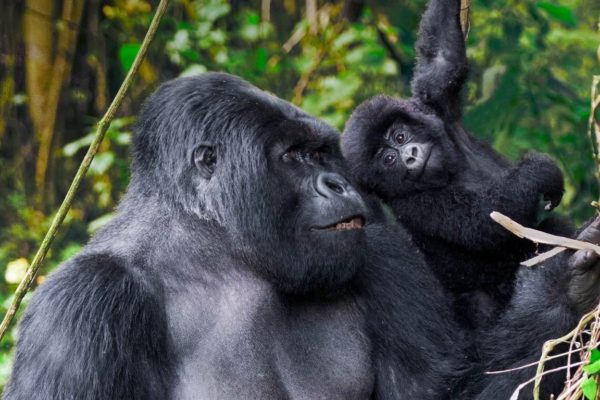What is Gorilla Habituation?
Gorilla habituation is the process of “taming” a group of extremely wild gorillas and getting them to be less aggressive to human visits. Upon the discovery of gorillas, human interest to visit and see them (up close) was birthed. However, because wild gorillas can be very aggressive, a plan to slowly get them accustomed to human visits (habituation) was necessary before humans could risk being attacked and killed by the gorillas – its this process that we now call Gorilla Habituation.
The habituation process usually lasts a period of 2-3 years and involves a team of qualified researchers and veterinarians (accompanied by the locals for extra support). The team sets out on a longterm mission to visit a selected wild gorilla group whilst closely studying its behaviour and getting it used to humans getting gradually closer and closer till the group accepts and gets tolerant to visits. It is after confirming that the group is accepting of human visits that it is considered ready for gorilla trekking.
Gorilla trekking is however limited to strictly 01-hour with the Gorillas to try an limit the human interferences that may arise with staying too long with the gorillas.
Where Can I do Gorilla Habituation?
Mountain Gorilla Habituation as an activity for tourists can only be done in Uganda and NOWHERE else in Africa.
In Uganda, gorilla habituation is done in the far-flung Rushaga & Nkuringo sectors of Bwindi impenetrable forest National Park. Bwindi is one of the two (02) places in Uganda where one can take part in perhaps the most sort after adventure activity of trekking to see Mountain Gorillas. Bwindi Forest is home to well-over 19 habituated gorilla groups with 2 still undergoing habituation open for gorilla trekking. The two (02) still undergoing habituation are Bikingi and Bushaho.
What does it cost to do Gorilla Habituation?
The Price of Gorilla Habituation permits in Uganda varies based on residence status as indicated below;
- Non-Residents (Foreign tourists) – USD1,500 per person.
- Residents (Expats) – USD1,000 per person.
- East Africans ( Uganda, Rwanda, Kenya, Burundi) – UGX750,000 per person.
***Rates mentioned above include guide fee, park entrance fees for the day and community development contribution.
Why is Gorilla Habituation so expensive?
While you are pondering and thinking Gorilla Habituation is expensive, be informed that Rwanda charges the same (USD1,500per person) for a standard 01 -hour with a group of habituated mountain gorillas in Volcanoes National park, it starts to sound more financially worthwhile spending USD1,500 to stay four (04) hours with a gorilla family in Uganda’s Bwindi Forest National Park.
The money charged as permit fees is re-invested in Gorilla conservation. remember there is only a few (approximately 1,000) of them left on earth. The numbers were far less before Gorilla trekking and habituation was introduced. Together lets support Gorilla conservation ( See: The Dian Fossey Gorilla Fund International).
How does Gorilla Habituation Compare to normal gorilla trekking?
- The price & the experience:
Gorilla trekking costs USD700 per persons and you get to spend only one (01) hour with an already habituated gorilla family. Gorilla habituation unlike Gorilla trekking costs more (USD1,500 per person) but allows you to spend four (04) hours with mountain gorillas still under habituation (still wild and not yet ready for gorilla trekking). Gorilla Habituation only takes place in regions that have mountain gorillas under habituation and as of now, it is only in Rushaga where new gorilla groups of Bikingi and Bushaho are under habituation.
Essential information worth reading before you go
Whats is the official age limit for Habituation?
Like it is with the regular gorilla trekking, the minimum age to go for the habituation experience is 15 years old.
Gorilla Habituation Permits.
Upon Inquiry about booking a habituation safari, we will revert to your email asking you to state the actual intended date(s) that you would prefer to do the habituation experience. We will then Contact Uganda Wildlife Authority for the availability of permit (s) for the date(s) you sent us. After confirming that there is gorilla habituation permit(s) available, then our consultant(s) will send you an email with all relevant information regarding your gorilla habituation permit booking procedure, documentation and safari payment plan.
Special Note: Just as is for gorilla trekking, so it is for habituation permits – full amount -US$1500 – in order to secure your Gorilla habituation permit.
Best time to go on a Habituation encounter
The best time to go is in the drier months of June-October and December to March when the area receives less rainfall and it is drier. This is also the time people have summer holidays. However, Bwindi Impenetrable Forest National park is a rain forest, meaning it can rain anytime of the year and of the day. The forest is wet most of the time and that is why we recommend that you come with a rain jacket for gorilla trekking and habituation. During the wet months, mountain gorillas do not move very far to look for their favourite food.
Gorilla Habituation rules and regulations.
- Keep a distance of about 5 to 7 meters which is about 15 feet from the Mountain Gorillas. This way you protect the mountain gorillas from diseases and illnesses humans may be carrying and not seem threatening to gorillas
- Stay together as a group when you are in the presence of the Gorillas to reduce potential confusion of the gorillas
- Voices need to be kept low and it is best to keep silence and just treasure the moment with the Mountain Gorillas.
- Do not partake of food or drinks and no smoking in the presence of the Mountain Gorillas.
- Don’t stare straight into gorillas’ eyes – this can be seen to be aggressive.
- Don’t ever run from a gorilla – if one approaches you just act submissive and crouch down.
- If you sneeze or cough, turn your head away from the gorillas so as not to spread your germs.
- No flash photography is permitted. Do not make a lot of movement when taking pictures-keep it calm.
- There is no touching or attempting to touch the Gorillas.
- Keep your voices down until you are well out of range of the Mountain Gorillas.
Read More about the habituation rules & regulations
What to wear/bring on your Gorilla habituation experience.
What to wear on the trek.
- Sturdy Lightweight walking shoes. the lighter the better. Extra weight on the trek is not good.
- Long-sleeved shirt and trousers to provide extra body protections against thorny shrubs.
- Long socks that allow you tuck you pants in to avoid bugs from climbing into your pants while on the trek.
- Rain jacket in case it rains. Remember you are trekking in a tropical rain forest.
- Gaiters (Optional). Don’t spend On new ones. These can well be substituted with long socks to serve the same purpose.
What to bring on the trek.
- A camera for your photographic needs. Don’t spend BIG on a camera. if you own an iPhone, they too take amazing pictures especial under limited forest light.
- Binoculars (optional). They might come in handy when spotting some forest birds. Your ranger guide will have a pair that he is willing to share.
- A hat (optional). This is to keep branches and leaves let alone bugs from falling into your hair.
- Drinking water. Check to see if your local operator will include this in the tour price.
- Packed Lunch. Check to see if your local operator will include this in the tour price.
- A Day Pack to carry all your personal items while on the trek. ** We recommend using a porter to carry your day pack for you (see: why to use a porter for Gorilla habituation)

